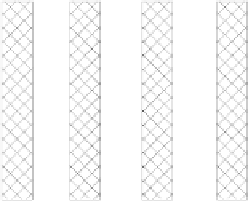Environmental Engineering Reference
In-Depth Information
With a radiation at collector level between 3,760 and 4,520 MJ/(m
2
a), this is
equivalent to an annual energy yield at the solar system outlet of between 1,200
and 1,450 MJ/(m
2
a) or 330 to 400 kWh/(m
2
a).
Stagna-
tion
Collector
Other components
ca. 25 %
ca. 10 %
ca. 5 %
ca. 23 %
ca. 3 %
ca. 7 %
ca. 1 %
Energy losses in relation to insulation on collector area
Fig. 4.10
Energy flow of a solar thermal forced-circulation system with flat-plate collector
to support the domestic water supply (e.g. /4-6/)
The dimensioning of installations and the coordinated layout of the individual
system components are decisive factors for the total system efficiency. The total
system efficiency and the solar fractional saving are interdependent. For a given
collector area the solar fractional saving increases with the increase of the effi-
ciency of the entire system (e.g. by using better collectors, reducing duct losses or
using better storage heat insulation or an increase in the storage volume). If the
solar savings are increased within a system that has already been designed, e.g. by
a lower demand for domestic hot water, the entire system efficiency is reduced.
The reason for this is that during the summer the collector converts too much ra-
diation into heat that cannot be utilised under these circumstances. If, on the other
hand, the collector area is enlarged, maintaining the design otherwise, the solar
fractional saving increases, but the entire system efficiency is also reduced, as the
main part of additional heat is generated during the summer, when the solar frac-
tional saving is already close to 100 %. Thus excess heat is lost during the sum-
mer.
4.2.4
System design concepts
The solar system consists of all the system components described above. The va-
riety of different system installations can be described according to the type of
heat transfer medium circulation. Thus,

























Search WWH ::

Custom Search